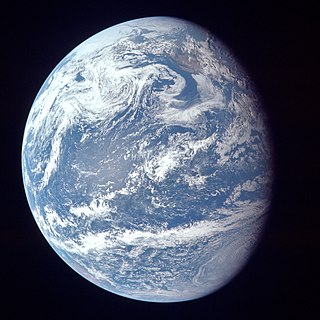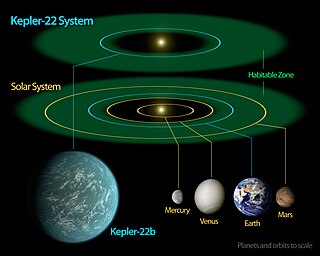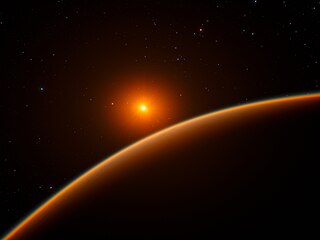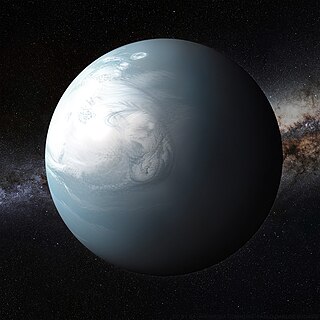Related Research Articles

An ocean world, ocean planet, panthalassic planet, maritime world, water world or aquaplanet, is a type of planet that contains a substantial amount of water in the form of oceans, as part of its hydrosphere, either beneath the surface, as subsurface oceans, or on the surface, potentially submerging all dry land. The term ocean world is also used sometimes for astronomical bodies with an ocean composed of a different fluid or thalassogen, such as lava, ammonia or hydrocarbons. The study of extraterrestrial oceans is referred to as planetary oceanography.

Gliese 581c is an exoplanet orbiting within the Gliese 581 system. It is the second planet discovered in the system and the third in order from the star. With a mass at least 5.5 times that of the Earth, it is classified as a super-Earth.

A Super-Earth is a type of exoplanet with a mass higher than Earth's, but substantially below those of the Solar System's ice giants, Uranus and Neptune, which are 14.5 and 17 times Earth's, respectively. The term "super-Earth" refers only to the mass of the planet, and so does not imply anything about the surface conditions or habitability. The alternative term "gas dwarfs" may be more accurate for those at the higher end of the mass scale, although "mini-Neptunes" is a more common term.
This page describes exoplanet orbital and physical parameters.

An exoplanet is a planet located outside the Solar System. The first evidence of an exoplanet was noted as early as 1917, but was not recognized as such until 2016; no planet discovery has yet come from that evidence. What turned out to be the first detection of an exoplanet was published among a list of possible candidates in 1988, though not confirmed until 2003. The first confirmed detection came in 1992, with the discovery of terrestrial-mass planets orbiting the pulsar PSR B1257+12. The first confirmation of an exoplanet orbiting a main-sequence star was made in 1995, when a giant planet was found in a four-day orbit around the nearby star 51 Pegasi. Some exoplanets have been imaged directly by telescopes, but the vast majority have been detected through indirect methods, such as the transit method and the radial-velocity method. As of 1 January 2024, there are 5,576 confirmed exoplanets in 4,113 planetary systems, with 887 systems having more than one planet. This is a list of the most notable discoveries.

HD 85512 b is a currently-disputed exoplanet orbiting HD 85512, a K-type main-sequence star approximately 37 light-years from Earth in the constellation of Vela.

Kepler-22b is an exoplanet orbiting within the habitable zone of the Sun-like star Kepler-22. It is located about 640 light-years from Earth in the constellation of Cygnus. It was discovered by NASA's Kepler Space Telescope in December 2011 and was the first known transiting planet to orbit within the habitable zone of a Sun-like star, where liquid water could exist on the planet's surface. Kepler-22 is too dim to be seen with the naked eye.
Kepler-61b is a super-Earth exoplanet orbiting within parts of the habitable zone of the K-type main-sequence star Kepler-61. It is located about 1,100 light-years from Earth in the constellation of Cygnus. It was discovered in 2013 using the transit method, in which the dimming effect that a planet causes as it crosses in front of its star is measured, by NASA's Kepler spacecraft.

Kepler-442b is a confirmed near-Earth-sized exoplanet, likely rocky, orbiting within the habitable zone of the K-type main-sequence star Kepler-442, about 1,206 light-years (370 pc) from Earth in the constellation of Lyra.
Kepler-296e is a confirmed super-Earth exoplanet orbiting within the habitable zone of Kepler-296. The planet was discovered by NASA's Kepler spacecraft using the transit method, in which the dimming effect that a planet causes as it crosses in front of its star is measured. NASA announced the discovery of the exoplanet on 26 February 2014.

K2-3d, also known as EPIC 201367065 d, is a confirmed exoplanet of probable mini-Neptune type orbiting the red dwarf star K2-3, and the outermost of three such planets discovered in the system. It is located 143 light-years away from Earth in the constellation of Leo. The exoplanet was found by using the transit method, in which the dimming effect that a planet causes as it crosses in front of its star is measured. It was the first planet in the Kepler "Second Light" mission to receive the letter "d" designation for a planet. Its discovery was announced in January 2015.
HD 219134 g, also known as HR 8832 g, is an unconfirmed exoplanet orbiting around the K-type star HD 219134 in the constellation of Cassiopeia. It has a minimum mass of 11 or 15 Earth masses, suggesting that it is likely a Neptune-like ice giant. Unlike HD 219134 b and HD 219134 c it is not observed to transit and thus its radius and density are unknown. If it has an Earth-like composition, it would have a radius 1.9 times that of Earth. However, since it is probably a Neptune-like planet, it is likely larger.
Wolf 1061d is an exoplanet orbiting the red dwarf star Wolf 1061 in the Ophiuchus constellation, about 13.8 light years from Earth. It is the third and furthest planet in order from its host star in a triple planetary system, and has an orbital period of about 217 days.

LHS 1140 b is an exoplanet orbiting within the conservative habitable zone of the red dwarf LHS 1140. Discovered in 2017 by the MEarth Project, LHS 1140 b is about 5.6 times the mass of Earth and about 70% larger in radius, putting it within the super-Earth category of planets. It was initially thought to be a dense rocky planet, but refined measurements of its mass and radius have found a lower density, indicating that it is likely an ocean world with 9-19% of its mass composed of water, or a dense mini-Neptune. LHS 1140 b orbits entirely within the star's habitable zone and gets 43% the incident flux of Earth. The planet is 49 light-years away and transits its star, making it an excellent candidate for atmospheric studies with ground-based and/or space telescopes.
Kepler-1652b is a super-Earth exoplanet, orbiting within the habitable zone of the red dwarf Kepler-1652 about 822 light-years away in the Cygnus constellation. Discovered by NASA's Kepler spacecraft, Kepler-1652b was first announced as a candidate in 2013, but wasn't validated until four years later in 2017. It is a potential super-Earth with 160% Earth's radius. The planet orbits well within the habitable zone of its system, the region where liquid water can exist on a planet's surface. The planet is an eyeball planet candidate.
TOI-700 is a red dwarf 101.4 light-years away from Earth located in the Dorado constellation that hosts TOI-700 d, the first Earth-sized exoplanet in the habitable zone discovered by the Transiting Exoplanet Survey Satellite (TESS).
Kepler-737b is a super-Earth exoplanet 669 light years away. There is a chance it could be on the inner edge of the habitable zone.

A hycean planet is a particular type of exoplanet that features a liquid water ocean under a hydrogen-rich atmosphere.

K2-332 b is a potentially habitable Super-Earth or Mini-Neptune exoplanet with a radius of 2.2 earths. It is in the empirical habitable zone, receiving 1.17 times the light that Earth gets from the sun. Its star, K2-332, is type M4V, with a temperature of ~3300 K. It was detected using the transit method in 2016 and is 402 light-years away.
References
- 1 2 3 4 Schanche, N.; Pozuelos, F. J.; et al. (January 2022). "TOI-2257 b: A highly eccentric long-period sub-Neptune transiting a nearby M dwarf". Astronomy & Astrophysics . 657: A45. arXiv: 2111.01749 . Bibcode:2022A&A...657A..45S. doi:10.1051/0004-6361/202142280. S2CID 240419956.
- 1 2 3 4 5 "TOI-2257 | NASA Exoplanet Archive". exoplanetarchive.ipac.caltech.edu. Retrieved November 17, 2023.
- 1 2 3 4 5 6 7 Nowakowski, Tomasz; Phys.org. "Astronomers discover a sub-Neptune exoplanet orbiting nearby star". phys.org. Retrieved November 17, 2023.
- 1 2 "PHL @ UPR Arecibo - The Habitable Exoplanets Catalog". phl.upr.edu. Retrieved November 17, 2023.
- ↑ Bern, University of (January 9, 2022). "Eccentric Exoplanet Discovered: Sub-Neptune Planet Orbiting in "Habitable Zone" of Red Dwarf Star". SciTechDaily. Retrieved November 20, 2023.
- ↑ "Exoplanet-catalog". Exoplanet Exploration: Planets Beyond our Solar System. Retrieved November 19, 2023.
- 1 2 Lea, Robert (November 15, 2021). "Astronomers Find Sub-Neptune Planet That May Have Liquid Water". Newsweek. Retrieved November 20, 2023.
- ↑ "Greenhouse effects... also on other planets". www.esa.int. Retrieved November 17, 2023.
- ↑ Hasler, Caroline (February 17, 2022). "Tidally Locked and Loaded with Questions". Eos. Retrieved November 17, 2023.
- ↑ "Obliquity and eccentricity determine exoplanet habitability". www.earthmagazine.org. Retrieved November 17, 2023.
- 1 2 Wang, Yuwei; Tian, Feng; Hu, Yongyun (July 2014). "Climate Patterns of Habitable Exoplanets in Eccentric Orbits Around M Dwarfs". The Astrophysical Journal Letters. 791 (1): L12. Bibcode:2014ApJ...791L..12W. doi: 10.1088/2041-8205/791/1/L12 . ISSN 2041-8205.
- ↑ "NASA's Hubble Finds Water Vapor on Habitable-Zone Exoplanet for 1st Time - NASA Science". science.nasa.gov. Retrieved November 20, 2023.
- ↑ Diamond-Lowe, Hannah; Kreidberg, Laura; Harman, C. E.; Kempton, Eliza M.-R.; Rogers, Leslie A.; Joyce, Simon R. G.; Eastman, Jason D.; King, George W.; Kopparapu, Ravi; Youngblood, Allison; Kosiarek, Molly R.; Livingston, John H.; Hardegree-Ullman, Kevin K.; Crossfield, Ian J. M. (October 2022). "The K2-3 System Revisited: Testing Photoevaporation and Core-powered Mass Loss with Three Small Planets Spanning the Radius Valley". The Astronomical Journal. 164 (5): 172. arXiv: 2207.12755 . Bibcode:2022AJ....164..172D. doi: 10.3847/1538-3881/ac7807 . ISSN 1538-3881.


